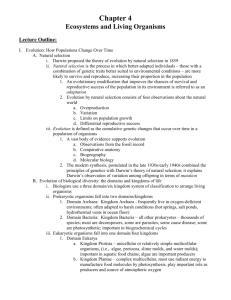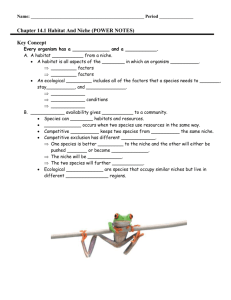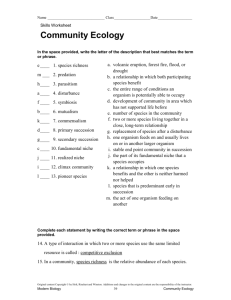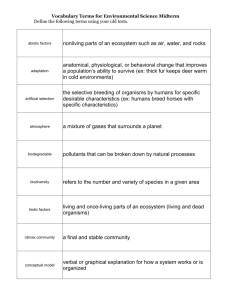chapter 5 outline
advertisement
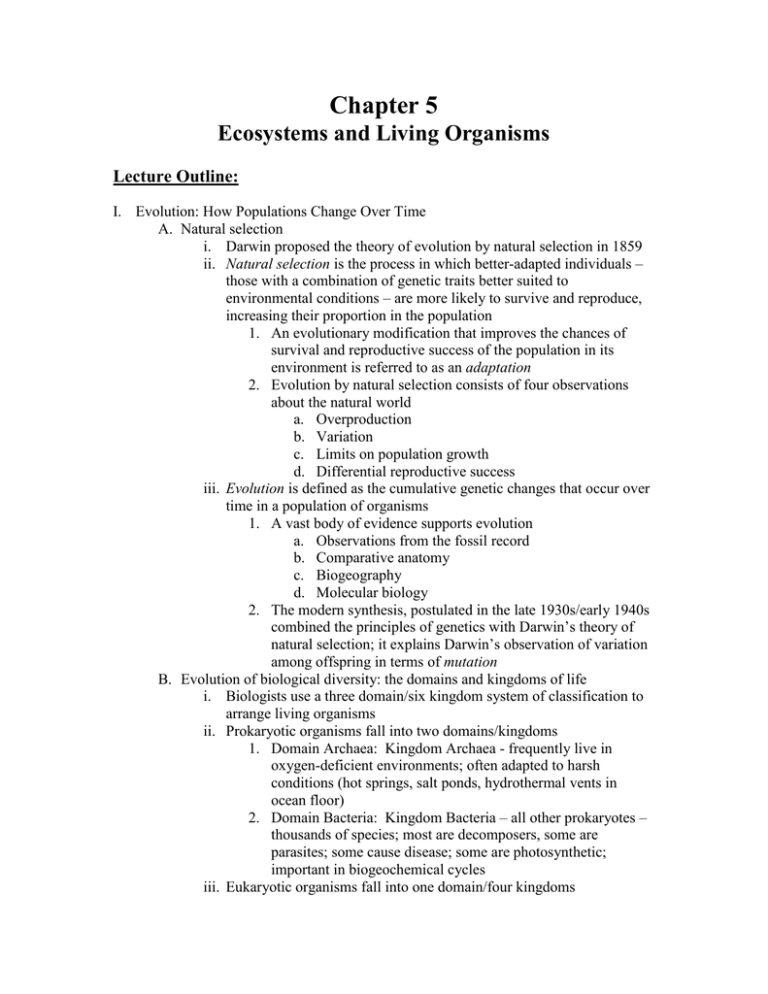
Chapter 5 Ecosystems and Living Organisms Lecture Outline: I. Evolution: How Populations Change Over Time A. Natural selection i. Darwin proposed the theory of evolution by natural selection in 1859 ii. Natural selection is the process in which better-adapted individuals – those with a combination of genetic traits better suited to environmental conditions – are more likely to survive and reproduce, increasing their proportion in the population 1. An evolutionary modification that improves the chances of survival and reproductive success of the population in its environment is referred to as an adaptation 2. Evolution by natural selection consists of four observations about the natural world a. Overproduction b. Variation c. Limits on population growth d. Differential reproductive success iii. Evolution is defined as the cumulative genetic changes that occur over time in a population of organisms 1. A vast body of evidence supports evolution a. Observations from the fossil record b. Comparative anatomy c. Biogeography d. Molecular biology 2. The modern synthesis, postulated in the late 1930s/early 1940s combined the principles of genetics with Darwin’s theory of natural selection; it explains Darwin’s observation of variation among offspring in terms of mutation B. Evolution of biological diversity: the domains and kingdoms of life i. Biologists use a three domain/six kingdom system of classification to arrange living organisms ii. Prokaryotic organisms fall into two domains/kingdoms 1. Domain Archaea: Kingdom Archaea - frequently live in oxygen-deficient environments; often adapted to harsh conditions (hot springs, salt ponds, hydrothermal vents in ocean floor) 2. Domain Bacteria: Kingdom Bacteria – all other prokaryotes – thousands of species; most are decomposers, some are parasites; some cause disease; some are photosynthetic; important in biogeochemical cycles iii. Eukaryotic organisms fall into one domain/four kingdoms 1. Domain Eukarya a. Kingdom Protista – unicellular or relatively simple multicellular organisms, (i.e., algae, protozoa, slime molds, and water molds); important in aquatic food chains; algae are important producers b. Kingdom Plantae – complex multicellular, most use radiant energy to manufacture food molecules by photosynthesis; play important role as producers and source of atmospheric oxygen c. Kingdom Fungi – most are complex multicellular, secrete digestive enzymes into their food and then absorb the predigested nutrients; decomposers; some are parasites; some cause disease d. Kingdom Animalia – complex multicellular, ingest their food and then digest it inside their bodies; consumers-herbivores, carnivores, omnivores, and detritivores II. Biological Communities A. A biological community and its abiotc environment comprise an ecosystem i. A community is an association of different populations of organisms that live and interact in the same place at the same time ii. Unraveling of the many positive and negative, direct and indirect interactions of organisms living as a community is one of the goals of community ecologists B. Succession: how communities change over time i. Succession is the process of community development over time, in which species in one stage are replaced by different species ii. Primary succession occurs when the change is species composition over time takes place in a previously uninhabited environment 1. Recently formed volcanic lava and rock scraped clean by glaciers represent previously uninhabited environments 2. The initial community that develops during primary succession is termed a pioneer community 3. Primary succession takes hundreds or thousands of years to occur iii. Secondary succession begins in an environment following destruction of all or part of an earlier community 1. Abandoned farmland and open areas caused by forest fires are common examples of secondary succession sites 2. Each stage of succession supports its own characteristic animal life III. Interactions Among Organisms A. Symbiosis defines any intimate relationship or association between members of two or more species i. The partners of a symbiotic relationship are termed symbionts ii. Thousands, even millions, of symbiotic associations that result from coevolution fall into three categories 1. Mutualism - both partners benefit (+,+) 2. Commensalism – one organism benefits and the other one is neither harmed nor helped (+,0) 3. Parasitism – one organism benefits and the other is adversely affected (+,-) a. When a parasite causes disease and/or death of a host, it is known as a pathogen b. Parasitism is a successful lifestyle; more than 100 parasites live in or on the human species alone B. Predation is defined as the consumption of one species (the prey) by another (the predator) i. Includes both herbivore-carnivore interactions and producer-herbivore interactions ii. Predation has resulted in an evolutionary “arms race” with the coevolution of predator and prey strategies 1. Pursuit and ambush 2. Plant defenses against herbivores 3. Defensive adaptations of animals C. Competition occurs when two or more individuals attempt to use an essential common resource such as food, water, shelter, living space, or sunlight i. Intraspecific competition occurs among individuals within a population ii. Interspecific competition occurs between species IV. The Ecological Niche A. The ecological niche is defined as the totality of an organisms adaptations, its use of resources, and the lifestyle to which it is fitted i. An ecological niche is basically determined by all a species’ structural, physiological, and behavioral adaptations ii. It includes the local environment in which an organism lives, its habitat, as well as the abiotic components of its environment (i.e., light, temperature, moisture) 1. The potential, idealized ecological niche of an organism is its fundamental niche 2. The lifestyle an organism actually pursues and the resources it actually uses make up its realized niche B. Limiting resources i. Any resource at a suboptimal level relative to an organism’s need for it or at a level in excess of an organism’s tolerance for it is a limiting resource ii. Limiting resources restrict the ecological niche of an organism, and often affect only one part of an organism’s life cycle C. Competitive exclusion and resource partitioning i. The idea of competitive exclusion holds that no two species indefinitely occupy the same niche in the same community due to competition between species; however, coexistence can occur if the overlap in the two species niches is reduced ii. Competition has an adverse effect on all species that use a limited resource iii. In resource partitioning, coexisting species’ niches differ from each other in one or more ways (i.e., timing and/or location of feeding, nest sites, etc.) V. Keystone Species A. A keystone species is a species, often a predator, that exerts a profound influence on a community in excess of that expected by it s relative abundance B. Keystone species are vital in determining the nature and structure of the entire ecosystem VI. Species Richness A. Species richness is defined as the number of species in a community B. Important factors determining species richness include: the abundance of potential ecological niches, closeness to the margins of adjacent communities, geographic isolation, dominance of one species over others, habitat stress, and geologic history i. Species richness is usually greater at the margins of adjacent communities than in the centers 1. Species richness is usually greater at the margins of adjacent communities than in their centers a. An ecotone is the transitional zone where two or more communities meet b. Ecotones contain all or most of the ecological niches of the adjacent communities as well as some niches unique to the ecotone 2. The change in species composition produced at ecotones is known as the edge effect ii. Species richness is inversely related to the environmental stress of a habitat iii. Species richness, ecosystem services, and community stability 1. Conservationists maintain that ecosystems with greater species richness better supply ecosystem services than ecosystems with lower species richness 2. Ecosystem services are important environmental benefits that ecosystems provide to people (i.e., clean air, water and fertile soil) 3. Community stability, the ability of a community to withstand environmental disturbances, is also thought to directly correlate with community complexity
